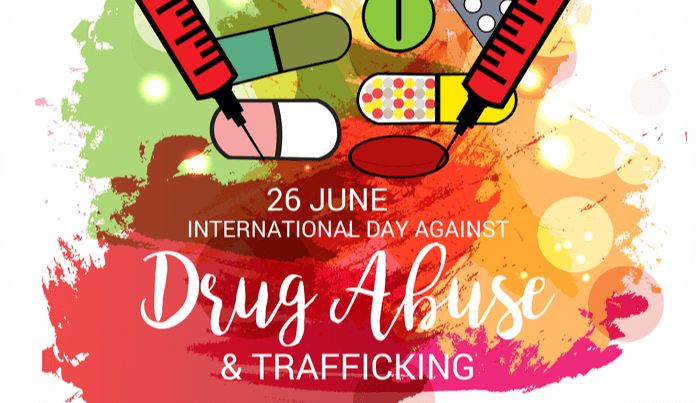Today is International Day for Drug Abuse and Illicit Trafficking. As a result, we will be taking a deeper dive into drug abuse also called substance abuse. This is a condition that is characterized by destructive patterned use of illegal or legal drugs or medication. The condition affects the person’s brain and behavior such that they are unable to control the use of the drug, to the point that it interferes with their ability to function. The drug user consumes the substance in amounts or with methods that are harmful to themselves or others. Some of the most commonly used drugs are alcohol, cocaine, opioids, benzodiazepines, cannabis, barbiturates, amphetamine, hallucinogens, inhalants, club drugs, and other substances.
There are over 190 million drug users around the world and the problem keeps increasing at an alarming rate, especially among young adults under the age of 30. Drug abuse can cause long-term damage to the body. Drug addicts who use needles are at a greater risk of having HIV and hepatitis B and C infections. People start to use drugs for so many reasons, some people start with the experimental use of recreational drugs, out of curiosity, to have a good time, or because friends are doing it (peer pressure which is the most common among teenagers). For others, drug abuse begins with exposure to prescribed medications from a friend or relative who has been prescribed the medications, particularly with opioids.
Over time you may need larger doses of the drug to get high and as drug use increases it may get extremely difficult to go without the drug. An attempt to stop the drug may cause intense cravings as well as getting physically ill. In 2015, substance use disorder resulted in three hundred and seven thousand four hundred (307,400) deaths, The highest numbers were from alcohol use disorders at around one hundred and thirty-seven thousand five hundred (137,500), opioids use disorder, had one hundred and twenty-two thousand one hundred (122,100) deaths, cocaine use disorders at eleven thousand one hundred deaths (11,100) and amphetamine use disorder at twelve thousand two hundred (12,200) deaths.
Effects
Each drug produces different physical effects on the brain. However, repeated use of a drug can alter the way in which the brain functions, including the way the brain feels pleasure. The addicting drug use causes changes in your brain that interfere with the ability to think, control your behavior, and at the same time send intense impulses to take drugs. It is because of this change in the brain that it is so challenging for an addicted person to stop taking drugs. Like many mental disorders, drug abuse has no single cause. Many factors may contribute to the development of drug addiction. The main factors are genetics, environmental factors such as parental abuse or neglect, family beliefs, exposure to peer groups that encourage drug abuse. Other factors that may affect the likelihood and speed of developing a substance addiction may include
- Psychological problems such as depression, anxiety, bipolar disorder as well as personality disorders
- Peer pressure
- Early use of drugs
- Unstable home environment
- Poor relationship with parents
- Inadequate supervision over adolescence activities
- Poor achievement in school
Symptoms
A regular urge to use drugs daily or even several times a day, recurrent substance use that prevents the user from meeting significant daily responsibilities at work, home, or school. Recurrent drug use in physically dangerous situations, withdrawal symptoms at every attempt to stop drug use, an unsuccessful trial of decreasing or controlling the use of the drug, cutting back on social or recreational activities because of drug use, continual use of the drug even though the person is aware of recurring physical or psychological problems caused or worsened by drug use, the need to keep or maintain a supply of the drug spending more money on the drug even though one can’t afford it, doing things you wouldn’t do such as going to the extent of stealing to get the drug.
Diagnosis and Treatment
A thorough evaluation that includes an assessment by a psychiatrist psychologist or licensed alcohol and drug counselor may be required for diagnosis. Blood, urine, or other lab tests are used in assessing drug use but they do not serve as a diagnostic test for substance abuse treatment. With the right treatment and support, it is possible to counteract the disruptive effect of drug use and regain control of your life. The primary goals of treatment are abstinence, relapse prevention, and rehabilitation. Treatment options may include chemical dependence treatment programs, detoxification, behavioral therapy, support from friends and family, doctor support groups or an organized treatment program that may help to overcome your drug addiction and stay drug-free. Let’s hear from the United Nations Office on Drugs and Crime (UNODC) Executive Director Ms. Ghada Waly on the importance of the theme of today.
“Knowing the facts about drugs can save lives. in 2020 an estimated 275 million people use drugs and over 36 million suffered from drug use disorders. According to the United Nations Office on Drugs and Crime (UNODC) World drug report, drugs are destroying health and stealing futures, with drug use alone killing almost half a million people in 2019. Awareness of the risks and access to evidence-based treatment and care can help prevent such tragedies. The covet pandemic has shown us the vital role of trustworthy scientific information and the power of the community in influencing health choices. We must urgently leverage this potential to address the world drug problem. The theme of this year’s international day against drug abuse and illicit trafficking is “Share Facts on Drugs Save Lives”. It highlights the need for evidence-based approaches to equip the public as well as health and service providers and decision-makers with the tools to inform choices and effective services.
Health and safety depend on reliable information. Over the last two decades, cannabis potency has almost quadrupled in the United States while doubling in Europe. But the percentage of adolescents who perceive regular cannabis use as harmful has decreased by as much as 40 percent. We need to fill gaps in trusted public information with greater investments in health science and data worldwide. Only one out of eight people in need of drug-related treatment receive it and new HIV infections among people who inject drugs are not declining. Governments need to expand evidence-based prevention and treatment programs as well as monitoring and early warning mechanisms to help lower-income countries detect encounter new substances and use trends. Let’s make verified information our ally as we address world drug challenges with shared responsibility and advance towards a vision of health for all.”
– Ms. Ghada Waly
United Nations Office on Drugs and Crime (UNODC)
Executive Director –




